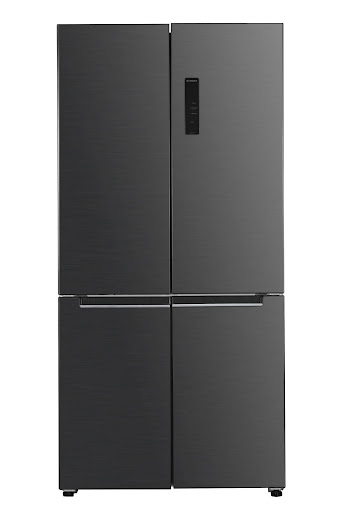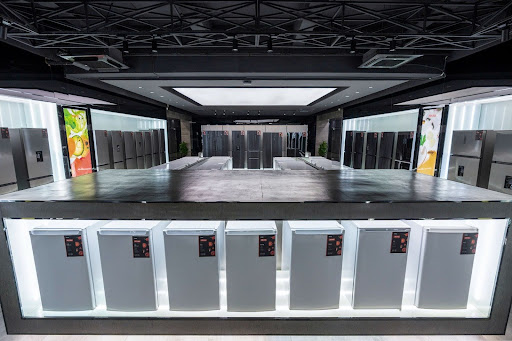Fresh veggies, juicy seasonal fruits, your favorite cut of beef, or a leftover pizza – all the food you bring home typically finds its place inside the large refrigerator standing in your kitchen. Storing all your food and groceries in a refrigerator helps maintain freshness, preventing spoilage and waste. But what if your refrigerator is adorned with thick layers of frost?
Built-up frost not only occupies precious space inside the refrigerator, reducing the available storage capacity for food items but can also interfere with the cooling mechanism of the refrigerator, forcing the compressor to work harder. Besides, frost inside a refrigerator can give your chilly friend a messy, unorganized, and nasty appearance. However, if your refrigerator is equipped with no-frost technology, your experience could be entirely transformed!
Why Would the Fridge Get Frost?
Large ice chunks on the refrigerator walls can be a nightmare, as they can disrupt efficiency and create storage inconvenience. But why does the fridge get frost in the first place? Here are some of the most common culprits of frost buildup in refrigerators:
- Damage or wear and tear on the freezer’s door seal can lead to cracks, enabling moisture ingress and causing frost buildup.
- Leaving the freezer door ajar allows the cold air to escape while allowing the warm air to creep in.
- A faulty thermostat hampers the activation of the heater, allowing ice to cake up on the refrigerator wall.
- A malfunctioning defrost heater can also cause frost buildup in the refrigerator.
- A defective defrost timer can disrupt the regular cycling between cooling and defrost modes, leading to frost buildup on the evaporator coils.
Impact of Frost on Food Preservation
Large blocks of ice can harm the fruits, vegetables, and other grocery items inside your fridge. A frost-laden fridge can lead to food dehydration (freezer burn), causing the food to lose its texture and flavor.
Moreover, if ice builds up on food items, it can accelerate the deterioration process, leading to spoilage and waste.
And lastly, frost can also have a detrimental impact on the fridge’s cooling mechanism. This can lead to uneven temperatures and inadequate preservation of perishable foods.
How to Defrost the Fridge?
How to wipe out that stubborn frost from your fridge? The frost-cleaning process is quite simple. Follow the steps below and remove all the extra ice from the refrigerator.
Unplug the Fridge
Unplug the refrigerator from the AC socket to ensure safety during the defrosting process.
Empty Your Appliance
Remove your food items from the refrigerator and freezer compartments. Place them in coolers with ice packs to keep them cold during defrosting.
Open the Fridge’s Door, Place Boiling Water, and Wait
No matter you have a 4-door fridge or a side-by-side refrigerator, leave the doors open to allow the ice to melt more quickly. To speed up the melting, you can place bowls of hot water inside the freezer and refrigerator compartments. Wait for the ice to melt.
Don’t forget to place towels or absorbent cloths around the base of the refrigerator to catch any water runoff.
Use a Hair Dryer to Accelerate the Melting
If there is too much frost in the fridge, you can get help from a hairdryer. Use the hairdryer on a low setting to gently melt the ice. However, be cautious not to take sharp objects to chip away at the ice, as this could damage the appliance.
How Does No-Frost Technology Prevent Frost in Fridge?
Manually cleaning ice stacks from the fridge compartments is a tedious task; this is why homeowners are increasingly opting for refrigerators with no-frost technology. It ensures the smooth functioning of the fridge while also preventing frost from forming inside its compartments, helping preserve the quality of frozen foods.
Air Circulation System
The frost-free technology uses advanced air circulation systems to evenly distribute cold air, ensuring consistent temperature within every compartment.
Auto-Defrosting Mechanism
Frost-free refrigerators are usually equipped with an auto-defrosting mechanism. It frequently melts the accumulated ice or frost, ensuring efficient cooling.
Humidity Control
Fridges designed with no-frost technology also incorporate humidity control settings that help regulate moisture levels within the compartments. This, in turn, minimizes condensation and prevents frost formation.
Frost-Free Refrigerators – For Better Food Preservation Environment
In 2013, a Chinese fridge manufacturer introduced its first completely no-frost refrigerator. And since then, the company has become the go-to choice among users for high-quality no-frost refrigerators. Their refrigerators combine cutting-edge no-frost technology to let you get rid of the perplex of frost on the fridge.
Today, powered by its latest technology in no frost, the fridges manufactured by this Chinese refrigerator exporter redefine no-frost technology on the market. The newest no-frost system dynamically controls the correct cooling and defrosting settings based on real-time usage patterns, ensuring optimal temperature regulation without the formation of frost. This advanced system not only preserves the freshness of your food but also minimizes energy consumption for sustainable operation.
Conclusion
With over a decade of expertise in cooling solutions, they are well-known for their superior no-frost technology. This fridge manufacturer offers a perfect blend of technology and adaptability with their advanced cooling and airflow systems coupled with carefully designed and sized compartments to ensure maximum efficacy. With plenty of options, advanced smart technology, and robust customer care services, their refrigerator will stand out as an ideal partner for any kitchen, offering both style and functionality. Contact them today!
Interesting Related Article: “How Faulty Fridge Can Affect Your Restaurant Business“

